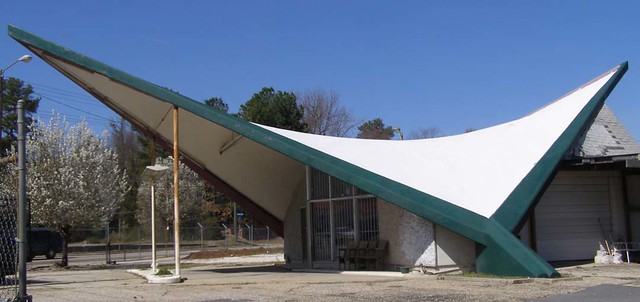 01-29-2022, 08:45 PM
01-29-2022, 08:45 PM
|
#970 (permalink)
|
|
Master EcoModder
Join Date: Aug 2012
Location: northwest of normal
Posts: 29,361
Thanks: 8,352
Thanked 9,118 Times in 7,528 Posts
|
At first I thought it was a tiny '55 Chevy.  en.wikipedia.org/wiki/Streamline_Moderne
en.wikipedia.org/wiki/Streamline_Moderne
At that time we had Googie Style gas stations in this location:

[ /farm4.staticflickr.com/3304/3342347837_ed2c1c5b97_z.jpg?zz=1]
Quote:
|
Googie architecture (/ˈɡuːɡi/ GOO-ghee[1]) is a type of futurist architecture influenced by car culture, jets, the Space Age, and the Atomic Age.[2] It originated in Southern California with the Streamline Moderne architecture of the 1930s, and was popular nationwide from roughly 1945 to the early 1970s.
|
Porcelain enamel gas stations:
Quote:
https://www.ohiohistory.org › visit › exhibits › ohio-history-center-exhibits › 1950s-building-the-american-dream › lustron-about › help-for-lustrons › meet-the-lustrons › meet-history
As well as a Brief History of Porcelain Enamel It was the use of this material, rather than the material itself, that was innovative. The process of enameling metal sheets had been developed in German and Austria in the mid-1800s.
ustron house - Wikipedia
Search domain en.wikipedia.orghttps://en.wikipedia.org › wiki › Lustron_house
Led by Chicago industrialist and inventor Carl Strandlund, who had worked with constructing prefabricated gas stations, Lustron offered a home that would "defy weather, wear, and time." Strandlund's Lustron Corporation, a division of the Chicago Vitreous Enamel Corporation, set out to construct 15,000 homes in 1947 and 30,000 in 1948.
|
__________________
.
.Without freedom of speech we wouldn't know who all the idiots are. -- anonymous poster
___________________
.
.Impossible is just something we haven't done yet. -- Langley Outdoors Academy
|
|
|

|